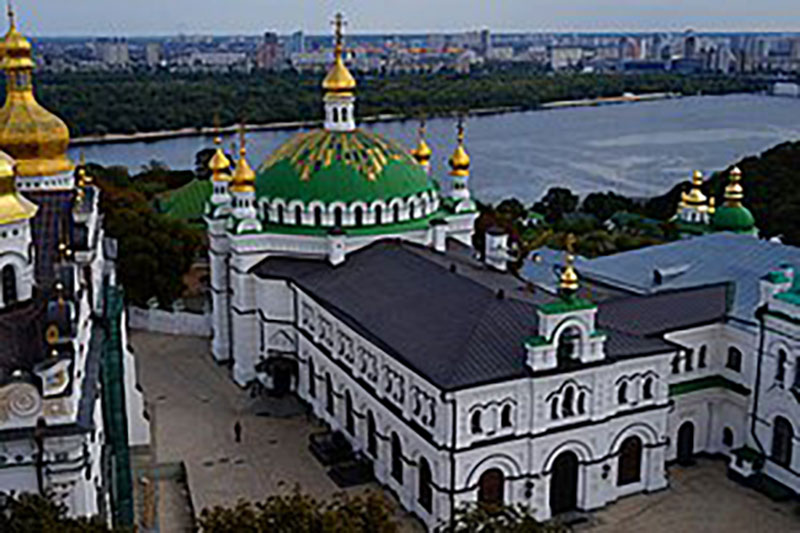Division in the Eastern Orthodox Church

There are approximately 260 million Orthodox Christians in the world, and the two largest nations where Orthodox Christianity predominates are Russia and Ukraine. The Eastern Orthodox Church in Constantinople (now Istanbul) broke away from the Roman Catholic Church in 1054, in what is usually termed “the Great Schism.” The chief dispute was over the authority of the Pope. After the fall of Constantinople in 1453 to Muslim armies of the Ottoman Empire, the main center of Orthodox Christianity became Moscow. There is no office equivalent to Pope in Orthodox Christianity, and national Orthodox churches have considerable autonomy.
Under 70 years of Communist rule, ending with the breakup of the Soviet Union in 1991, Christianity and the Russian Orthodox Church were severely persecuted. In the first five years after the Communist Revolution in 1917, 28 Russian Orthodox bishops and 1,200 Russian Orthodox priests were executed. This persecution was most severe under Stalin. During the 14 months of the Stalinist terror of 1937 and 1938, the NKVD ( Internal Security Police) executed, 20,761 political dissidents just south of Moscow at a field called the Butovo Firing Range. Over one thousand of them were Russian Orthodox priests and bishops. Most of them were shot in the back of the head, a favorite Communist method of quick execution.
In Rod Dreher’s 2020 book, Live Not by Lies, he relates the confession of a prison guard who witnessed the execution of at least 20 Russian Orthodox priests in a more rural setting. The NKVD would gather 20 to 30 priests they had been holding in prison and take them far out in the woods for execution. They gave them a chance to renounce their faith, but none the guard saw ever denied their faith. They shot them one by one in the forehead as they confirmed their faith in God.
Yet the Russian Orthodox Church and Christianity were never completely crushed. The really significant spiritual story here is the amazing resurgence of Christianity in Russia and Ukraine since 1991. According to the Pew Research Center, the percentage of Russian adults identifying as Christian increased from 31 percent in 1991 to 72 percent in 2008. This is difficult to measure, because mere identification as a Christian is not the same as having knowledgeable and committed personal faith in Christ as Lord and Savior. Nevertheless, it is remarkable and increasingly visible.
In October 1990, the Bishops’ Council of the Russian Orthodox Church (ROC) granted independence and self-governance to the Ukrainian Orthodox Church (UOC) but continued its tradition of spiritual guidance by the Moscow Patriarchate, which had existed since about 1686. Essentially the Ukrainian Orthodox Church has been an autonomous church within the greater umbrella of the Russian Orthodox Church. Thus the term, “autonomous,” can be a bit ambiguous in Ukraine’s ecclesiastic currency. Especially since 2014, many Orthodox Ukrainians want to be “autocephalous,” which means having no church authority outside Ukraine.
We need to review some demography to further clarify the situation. You have probably seen the maps. Eastern and Southern Ukraine, colored blue on the political maps, and including the whole coastal strip on the Sea of Azov, between Crimea and the Donbas Republics, leans toward Russian politics, economics, and religion. These areas have favored pro-Russian political policies and also tend to favor the traditional relationship between the Ukrainian Orthodox Church and the Moscow Patriarchate. Western Ukraine, colored red on the political maps, has leaned toward its western neighbors, who belong to the European Union and NATO. Western Ukraine cherishes Ukrainian independence and is fearful and suspicious of Russian dominance. (See map on my March 21, article, The Biden Shadow over Ukraine)
In 2010, Viktor Yanukovych was elected President of Ukraine with 49 percent of the vote against Yulia Tymoshenko with 46 percent. Yanukovych was from Eastern Ukraine and tried to balance those needs with those of Western Ukraine. In November 2013, massive protests erupted in Kyiv and other cities, because Yanukovych delayed approving Ukraine’s membership in the European Union (EU), which Parliament had approved. Russia had made an offer of $15 billion in loans and cheaper fuel costs if Ukraine joined the Russian dominated Eurasian Economic Union. The EU could not come near matching it. In January and February 2104, the protest crowds, now called the “Maidan Revolution,” grew larger and more violent. On February 18 to 23, hundreds of thousands of protestors clashed with security police, and 121 people, including 13 police were killed. When the police were ordered to leave on February 23, the crowds remained in control of Independence Square in Kyiv. Parliament abandoned support for Yanukovych, and he fled to Russia. A new election was held, and billionaire oligarch Petro Poroshenko was elected with 55 percent of the vote on May 25. He favored a pro-Western and anti-Russian agenda. Many Ukrainians and conservative American and British scholars believe the Maidan Revolution was a U.S. State Department orchestrated coup d’état.
Poroshenko and his new Ukrainian government decided to pursue complete Ukrainian independence from the Russian Orthodox Church (ROC). But not all the Ukrainian Orthodox Church (UOC) wanted to pursue this goal of complete separation. Thousands of Orthodox churches and hundreds of monasteries cherished the centuries-old jurisdictional relationship. In all, there are about 12,000 Orthodox churches and 250 monasteries in Ukraine. Ukraine now has two main Orthodox Church denominations—the Ukrainian Orthodox Church (UOC) Moscow Patriarchate and a new church, the Orthodox Church of Ukraine OCU) with its own Patriarch in Kyiv.
In 2018, the Poroshenko government and some OCU bishops, with the help of U.S. Vice President Joe Biden, persuaded Bartholomew, the nominal ecumenical patriarch of Constantinople (in Muslim Istanbul) to approve complete “autocephaly” for the Orthodox Church of Ukraine. Dr. Steve Turley, author and YouTube news channel commentator, who is an Orthodox church member, brought this to public attention on his 15-minute November 20, 2018, YouTube presentation. See also Eureporter November 2, 2021. This was during a time that both Joe and Hunter Biden were weaving a corrupt web of influences and high-paid corruption in Ukraine.
The Russian Orthodox Church Patriarch Kirill was naturally outraged, and on October 12, 2018, Russian President Vladimir Putin vowed to defend the rights of Orthodox Churches and members in Ukraine. Both Russian and Ukrainian orthodoxy emphasize faithfulness to the doctrinal and moral teachings of Scripture and strong social and family conservatism. Putin often speaks against the woke, distorted moral compass of the U.S. and Western Europe.
Dr. Turley often speaks of the growing global trend to reject secular globalism and its moral degeneracy and return to traditional values of culture, politics, and religion. He includes the emergence of Donald Trump and the recent Virginia gubernatorial election as examples in the U.S, but also Brexit and similar trends in Europe.
More demographics should help you understand the religious and political framework of Russia and Ukraine.
A U.S. State Department report in 2021 indicated that 63 percent of Russians identified with the Russian Orthodox Church and 7 percent identified as Muslims. A recent 2022 report by Russian Public Opinion Research indicated 68 percent of Russian adults were Russian Orthodox, a little over one percent were Protestant or Roman Catholic, 6 percent were Muslim, 4 percent belonged to other religions, and about 20 percent had no interest in religion. Several other surveys indicated that approximately one-third of those who identify as Russian Orthodox are not actually associated with a specific Orthodox congregation. Regional detail within the Russian Federation indicates that Russian Orthodoxy is strongest west of the Ural Mountains and weaker in the Caucus and Asia, where some political divisions are actually majority Muslim or where older pagan or nature religions have significant minority influence.
The Christian Science Monitor claimed in 2011 that Russia had become the most Christian country in Europe, but I believe that title may belong to Poland or perhaps Ukraine. The percentage of the U.S. population that identifies as Christian has been dropping rapidly and at 65 percent is now below Russia, Ukraine, and Poland. Secular globalism and Social Marxist dominance in education, government, and the media are taking a heavy toll. A large part of the recent decline in Christian percentages, however, is undoubtedly due to high rates of new immigration from predominantly non-Christian nations.
A Pew Survey in 2017 showed 72 percent of Russians identified as Christians, while the same Pew survey showed 71 percent for Ukraine in 2018. A survey of both countries in 2016, and perhaps adjusted for the political changes resulting from the 2014 war, was released in January 2019. This showed Ukraine was 78 percent Orthodox and 10 percent mostly Greek Catholic, bringing the Christian total to about 88 percent. Russia remained 71 percent Orthodox, which would probably bring the Christian total to 73 percent. This rather nice jump for Ukraine may reflect a recapitulation of the data, excluding Crimea and the Donbas Republics from the Ukraine. Crimea’s population of about 2.5 million is 68 percent Russian, only 16 percent Ukrainian, and 15 percent Muslim. Russian Orthodox adherents make up about 58 percent of the population. The combined population of the two Donbas republics, sometimes now referred to as New Russia, was about 3.8 million in 2018. Native Russian speakers run from 68 to 74 percent of the population, which is 65 percent Christian, of which 51 percent are Orthodox. About 6 percent of the population is Muslim. If the present Ukrainian government wants safer elections for pro-Western political candidates, it would to their pollical advantage to be without Donbas and Crimea.
Many areas of Western Ukraine are majority Greek Catholic, rather than Orthodox, including the city of Lviv, which was once part of the Austria-Hungarian Empire and before 1939, part of Poland.
There are 12,000 Orthodox churches and parishes in Ukraine, but a May 2019 report by the European Council of Foreign Relations noted that the UOC Moscow Patriarchate claimed 11,000 churches in Ukraine, while the new OCU Kyiv Patriarchate claimed 7,000. The OCU website quotes the Kyiv International Institute of Sociology study in 2021 finding they had 7,000 churches and parishes and 58.2 percent of the Orthodox population. There could be a propaganda battle going on here. The fear of many Russians, especially the 17 percent of the population of Ukraine who are native Russian speakers, is that the Ukrainian government will force UOC Moscow Patriarchate churches, with their church properties and members into the OCU Kyiv Patriarchate. The OCU already seems more focused on politics than faith and peace.
Almost nobody in the West is saying the Ukrainian War is about religion. The Western establishment and media are too secularized to believe anyone could be motivated by religious issues, especially conservative values. But Putin and the Russian Orthodox Church have been claiming for a long time that the conflict in Ukraine is really a conflict between the West’s decadent secular globalism against a Russian and Slavic return to traditional values, religion, and political forms. There may be some truth to these claims, but Putin’s bombing and blasting Ukrainian cities and the high civilian casualties that resulted have thrown a dark blanket over his argument. He has made a terrible mistake, not only for himself, but for Russia and the future hopes of the Russian people.
I agree with British conservative leader, Nigel Farage, who was on the Tucker Carlson show on March 30. We cannot side with Putin or this Russian invasion of Ukraine, but NATO and the EU added to its coming by thoughtlessly poking the Russian Bear in 2014 and since.









 Mike Scruggs is the author of two books: The Un-Civil War: Shattering the Historical Myths; and Lessons from the Vietnam War: Truths the Media Never Told You, and over 600 articles on military history, national security, intelligent design, genealogical genetics, immigration, current political affairs, Islam, and the Middle East.
Mike Scruggs is the author of two books: The Un-Civil War: Shattering the Historical Myths; and Lessons from the Vietnam War: Truths the Media Never Told You, and over 600 articles on military history, national security, intelligent design, genealogical genetics, immigration, current political affairs, Islam, and the Middle East. 


